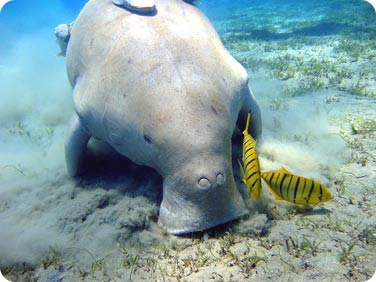Saudi Arabia is home to some of the most desolate land on Earth. In the giant Rub Al-Khali and an-Nafud deserts, temperatures can soar to 140 degrees Fahrenheit, and frequent sandstorms fill the sky with choking dust. Yet not so far from the desert, life is abundant: in the extensive coral reefs of the Red Sea. Saudi Arabia’s Red Sea coastline is about 1100 miles long, and coral reefs fringe most of it. They’re home to several hundred species of coral, plus hundreds more species of fish, crustaceans, and other creatures.
 Al-Wadj Bank is home to a large population of dugong. Credit, wikipedia, Julien Willem.
Al-Wadj Bank is home to a large population of dugong. Credit, wikipedia, Julien Willem.One of the most impressive reef systems is the Al-Wadj Bank along the northern coast. The reefs have built small islands, which are surrounded by lush beds of seagrass.
These beds are home to one of the world’s largest populations of dugong, which are cousins of the manatee. They spend most of their time feeding on the seagrass, sometimes using their snouts and short tusks to uproot them. These friendly creatures grow up to 8 to 10 feet long, and their life cycle is a lot like our own: they reach maturity at around the same age as humans, and they can live for 70 years or longer.
Like Al-Wadj, many of Saudi Arabia’s reefs are in pretty good shape. The main exception is around the port city of Jeddah. Pollution, dredging, overfishing, and other human-caused problems have damaged or destroyed many reefs, and threaten many others. Environmentalists are concerned that without quick action, the reefs of Jeddah could soon become as barren as the desert sands.

